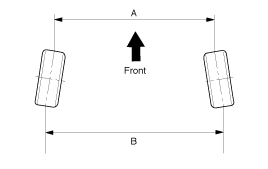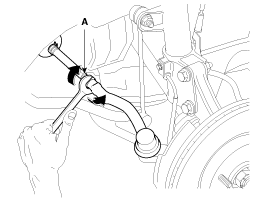Kia Optima Hybrid: Tires/Wheels / Alignment Repair procedures
Kia Optima Hybrid (TF HEV) 2016-2020 Service Manual / Suspension System / Tires/Wheels / Alignment Repair procedures
| Front wheel alignment |
When using a commercially available computerized wheel
alignment equipment to inspect the front wheel alignment, always
position the vehicle on a level surface with the front wheels facing
straight ahead.
Prior to inspection, make sure that the front suspension and
steering system are in normal operating condition and that the tires are
inflated to the specified pressure. |
Toe

B - A > 0: Toe in (+)
B - A < 0: Toe out (-) |
Toe adjustment
| 1. |
Loosen the tie rod end lock nut. |
| 2. |
Remove the bellows clip to prevent the bellows from being twisted. |
| 3. |
Adjust the toe by screwing or unscrewing the tie rod. Toe
adjustment should be made by turning the right and left tie rods by the
same amount.
|
| 4. |
When completing the toe adjustment, install the bellows clip and tighten the tie rod end lock nut to specified torque.
|
| 5. |
Compensate the steering angle sensor after adjusting the wheel alignment.
(Refer to Steering System - "Steering Column-Shaft") |
Camber and Caster
Camber and Caster are pre-set at the factory, so they do not
need to be adjusted. If the camber and caster are not within the
standard value, replace or repair the damaged parts and then inspect
again.
Camber angle: -0.5° ± 0.5° |
Caster angle : 4.34° ± 0.5° |
| Rear wheel alignment |
When using a commercially available computerized wheel
alignment equipment to inspect the rear wheel alignment, always position
the vehicle on a level surface.
Prior to inspection, make sure that the rear suspension
system is in normal operating condition and that the tires are inflated
to the specified pressure. |
Toe

B - A > 0: Toe in (+)
B - A < 0: Toe out (-) |
Toe adjustment
| 1. |
Loosen the nut holding the assist arm cam bolt (A). |
| 2. |
Adjust rear toe by turning the rear assist arm cam bolt (A)
clockwise or counter clockwise. Toe adjustment should be made by turning
the right and left cam bolt by the same amount.
|
| 3. |
When completing the toe adjustment, tighten the nut to specified torque.
|
Camber
Camber is pre-set at the factory, so it does not need to be
adjusted. If the camber is not within the standard value, replace or
repair the damaged parts and then inspect again.
Camber: -1.0° ± 0.5° |
 Wheel Repair procedures
Wheel Repair procedures
Hub nut tightening sequence Tighten the hub nuts as follows. Tightening torque: 88.3 ~ 107.9N.m (9.0 ~ 11.0kgf.m, 65.1 ~ 79.6lb-ft) When using an impact gun, final tightening torque should ...
Other information:
Kia Optima Hybrid (TF HEV) 2016-2020 Service Manual: Front Washer Motor Repair procedures
Inspection 1. With the washer motor connected to the reservoir tank, fill the reservoir tank with water. Before filling the reservoir tank with water, check the filter for foreign material or contamination. if necessary, clean the filter. 2. Connect positive (+) battery cables to terminal ...
Kia Optima Hybrid (TF HEV) 2016-2020 Service Manual: Front Hub / Knuckle Components and Components Location
Components 1. Driveshaft nut2. Brake disc3. Hub4. Wheel bearing5. Snap ring6. Dust cover7. Knuckle8. Driveshaft ...
© 2025 Copyright www.koptimatfhev.com




